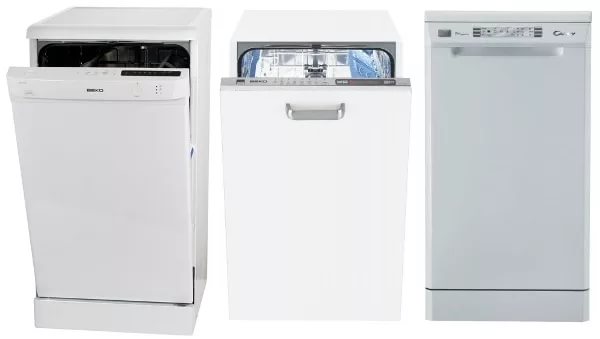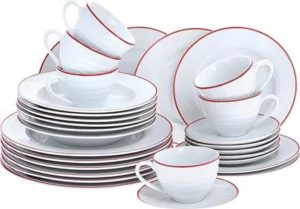Which dishwasher is better, 45 or 60 cm wide?
 When thinking about purchasing a dishwasher, housewives immediately imagine how they will lie on the sofa while the appliances wash the dishes and pots for them. Complete advantages: a whole manicure, healthy skin on your hands, and you don’t have to stand at the sink for half an hour playing with a sponge and towel. Everything would be fine, but the time comes when you need to choose a dishwasher, and here the question arises: which dishwasher is better? First of all, we are interested in the size, 45 or 60 cm? Let’s figure it out together what experts and experienced housewives think about this.
When thinking about purchasing a dishwasher, housewives immediately imagine how they will lie on the sofa while the appliances wash the dishes and pots for them. Complete advantages: a whole manicure, healthy skin on your hands, and you don’t have to stand at the sink for half an hour playing with a sponge and towel. Everything would be fine, but the time comes when you need to choose a dishwasher, and here the question arises: which dishwasher is better? First of all, we are interested in the size, 45 or 60 cm? Let’s figure it out together what experts and experienced housewives think about this.
Let's think about the selection criteria
Experienced housewives who have been using a dishwasher for several years now advise you to think very carefully about the size of your future “home assistant”. Let's assume that you haven't taken any steps yet, but are just thinking about buying a dishwasher, what should you think about first? Of course, about where you will put your new equipment and how to connect it.
Many people have small kitchens in their apartments and houses, so they have to save space. Quite often, there is simply nowhere to put a full-size 60 cm dishwasher, and in this case the dilemma will resolve itself, because a 45 cm dishwasher is narrower, and it is easier to find a place for it. If there is potentially room for a 45 or 60 cm machine, you will have to decide on other selection criteria.
- How many people are in the family and how often do you receive guests? A very important criterion that determines the intensity
 load on the dishwasher. Everything is simple here. If you often wash a huge amount of dishes, then you need a dishwasher with the maximum possible load, and these are 60 cm machines.
load on the dishwasher. Everything is simple here. If you often wash a huge amount of dishes, then you need a dishwasher with the maximum possible load, and these are 60 cm machines. - Composition of dishes. Quite often you have to wash not only plates, glasses and spoons with forks. Dirty dishes include large salad bowls, baking sheets, large pots and pans. For large dishes, a full-size dishwasher is better suited.
- Water consumption and energy consumption. I would like to buy a functional, but at the same time most economical machine. To do this, you will have to look at the data sheets of specific dishwasher models and find information about energy consumption and water consumption there.
Water and energy consumption depends not so much on the size of the dishwasher, but on the programs and functions built into it.
- Placement of baskets for dishes. The quality of washing depends on how you arrange dishes in baskets; accordingly, the more convenient these baskets are, the easier it is to handle the dishwasher. The manufacturer takes great care when designing dishwasher baskets, and many models are now equipped with adjustable baskets. Now the user can set them as needed so that the dishes fit properly.
- Composition of programs and functions. Any modern dishwasher should have an impressive range of useful programs and functions. In particular, the half load mode, when the dishwasher uses half as much water and energy on fewer dishes.

- Noise. If the dishwasher produces noise of more than 55 dB during operation, it is better not to buy such a dishwasher. Normal noise range is 45-52 dB.
- Manufacturer. For many, the brand of the dishwasher and the country of assembly are of great importance.In this sense, in first place are German brands and dishwashers assembled in Germany, in last place are “home assistants” assembled in Russia. China is now somewhere in the middle. If you are seriously thinking about the question, which brand to buy a dishwasher, read the article of the same name.
- Protection. Good dishwashers are protected from leaks and child tampering. They are equipped with filters that will protect the machine if low-quality water is supplied to the water supply. In our opinion, you should not give up such pleasant additions; besides, they are very useful.
Here is the main list of criteria that you can rely on when choosing a dishwasher. Of course, not all criteria are relevant to the question: a 45 or 60 cm dishwasher is worthy of choice, but if you look at these very criteria together, you will get a picture of the ideal machine that you will look for on store shelves.
Advantages and disadvantages of the 45 cm machine
Now all we have to do is briefly highlight the advantages and disadvantages of each of the presented “size ranges” of dishwashers, so that you get an even more complete idea of what type of equipment to give preference to. We will start with the pros and cons of a dishwasher with a body width of 45 cm.
Don’t be surprised if somewhere in the texts of the remaining points the thoughts outlined earlier are repeated. We will do this deliberately in order to correctly place emphasis and present the material in a more visual form for easier assimilation by the reader. So, the advantages that a 45 cm machine has.
- Compact and ergonomic body.In this case, we are talking not so much about saving space, although this is very important, but about the ergonomics of placing equipment within the kitchen space. In a small kitchen, a 45 cm dishwasher with a narrow body looks much more organic, and it is also somewhat easier to integrate into furniture than a full-size one.
The narrow dishwasher fits easily into a standard-sized cabinet. You don’t even need to invent anything special.
- More diverse model range. Marketers have long noticed that narrow dishwashers sell better, so the manufacturer, reacting to this fact, is constantly expanding the offer of machines with a cabinet width of 45 cm. Hence the conclusion: narrow dishwashers have a wider range of models, more choice, which means it will also be easier to choose the “ideal helper” for yourself.

- It’s easier to choose a ready-made facade. Due to the fact that built-in dishwashers with a cabinet width of 45 cm are much more popular, they have ready-made facades in almost any color and texture. For a 60 cm dishwasher you have to order a front, and this is an extra headache.
Let’s add to the above advantages the opportunity to save an extra 15 cm of space in your kitchen, and it turns out that there is a lot in favor of buying a 45 cm model. However, let’s not rush to conclusions; let’s talk about the disadvantages of narrow cars.
- Some dishes really don't fit into it. Try stuffing a standard-width baking sheet or a huge pan into a narrow hopper? Even if you succeed, you won't be able to put anything else in there. But large, greasy baking sheets, pots and pans are very difficult to wash by hand. The conclusion suggests itself.
- Service life and technical solutions.In the narrow body of the dishwasher, the parts are arranged more compactly. Technical solutions are used that are more aimed at cramming more elements into a small body, rather than at extending the service life of the machine. The statistics are inexorable; narrow cars last on average 2-2.5 years less than full-size ones.
- Not suitable for large families. A narrow dishwasher fits much less dishes than a full-size machine - that’s a fact. If you have more than 4 people living in your house, a narrow machine will not suit you.
Pros and cons of 60 cm dishwashers
With narrow models everything is clear. Although manufacturers and marketers never tire of praising them, such dishwashers also have obvious disadvantages that should be taken into account. What about standard dishwashers? In our opinion, the fact that dishwashers with a width of 60 cm are considered standard and traditionally used throughout the world says a lot. They have a number of undeniable advantages.
- Large capacity. If you need to stuff a whole mountain of plates and glasses, please, a couple of pans and a baking sheet – no problem either. At the same time, you don’t even have to rack your brains about how and what to put in order to clean it better.
A full-size dishwasher holds 16 or more place settings.
- High quality dishwashing. The looser the dishes are, the higher the quality of washing. It's difficult in a narrow bunker
 to achieve this, in a 60 centimeter model it is elementary.
to achieve this, in a 60 centimeter model it is elementary. - The presence of modes that allow you to save water and electricity. In the past, large dishwashers were not economical. Now, with the advent of electronic control systems, programs appear that allow you to load the machine halfway and set a half-load program, and this is pure savings.
Large dishwashers also have disadvantages, and they are related to the size of the “home assistant” body. It’s problematic to fit it into a small kitchen, and there’s nothing to say about embedding it. A 60 cm built-in machine will take up a lot of space. But if you have a large kitchen, then these disadvantages automatically lose their significance.
Interesting:
2 reader comments
Add a comment Cancel reply
Categories
Washing machine repair


For buyers

For users

Dishwasher

















Who cares, I guess. I personally don’t need 60 cm; Hotpoint 45 is enough. Yes, it is more convenient to place baking trays in a wider one, for example. But I don't use the oven very often.
And I have Indesit, and a larger one, it’s ideal to wash bulky dishes in it, otherwise everything around the sink used to be in water :)